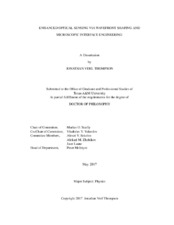| dc.description.abstract | Optical methods have become an integral part of today’s sensing and spectroscopic techniques. These techniques provide many tools that are used for research, security, safety and health. However, attenuation effects, like scattering, limit the effectiveness of these optical tools to situations when the attenuation is low. Through deeper understanding of the scattering interactions between light and matter, we show that these detrimental effects can be mitigated, thereby enhancing our optical detection range and sensitivity.
Here we investigate and demonstrate the application of advanced techniques in a way that enhances optical signal and sensitivity in the presence of optically dense, nonlinear, or highly scattering materials. In particular, we focus on situations when slight modifications to the light or optical interface geometry result in large signal enhancements. First, we demonstrate the generation of a backward and directional superfluorescent emission from a dense Sodium vapor. We then investigate the use of wavefront shaping technologies to focus light through scattering materials, and in particular, use this to enhance Raman scattering signal through the material. Wavefront shaping methods are also used to demonstrate second harmonic generation with an enhanced efficiency from a nonlinear crystal in both the forward and backward directions. Furthermore, phase modulation in the frequency domain (pulseshaping) is used to increase the amplitude of selected frequency components after a femtosecond pulse undergoes filamentation. Lastly, we demonstrate that by focusing light into a microscopic hole ablated into the surface of a highly scattering material, we can trap the light inside the material for a much longer period of time than if the light was merely focused onto the surface. This is especially useful for linear spectroscopic detection methods (such as Raman scattering and fluorescence) than benefit greatly from an increased optical interaction time. These techniques show that by utilization of the interaction of light with matter, it is possible to overcome the current limits of sensing and detection in the presence of scattering and other attenuation effects. | en |


